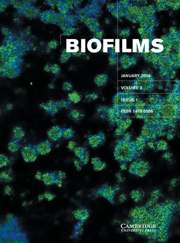Crossref Citations
This article has been cited by the following publications. This list is generated based on data provided by
Crossref.
Ngo Thi, N. A.
and
Naumann, D.
2007.
Investigating the heterogeneity of cell growth in microbial colonies by FTIR microspectroscopy.
Analytical and Bioanalytical Chemistry,
Vol. 387,
Issue. 5,
p.
1769.
Tetz, George V.
Artemenko, Natalia K.
and
Tetz, Victor V.
2009.
Effect of DNase and Antibiotics on Biofilm Characteristics.
Antimicrobial Agents and Chemotherapy,
Vol. 53,
Issue. 3,
p.
1204.
Tetz, Victor V.
and
Tetz, George V.
2010.
Effect of Extracellular DNA Destruction by DNase I on Characteristics of Forming Biofilms.
DNA and Cell Biology,
Vol. 29,
Issue. 8,
p.
399.
Tetz, G. V.
Artemenko, N. K.
Zaslavskaya, N. V.
and
Tetz, V. V.
2013.
Characteristics of Bacterial Biofilms during Long-Term Culturing.
Bulletin of Experimental Biology and Medicine,
Vol. 155,
Issue. 4,
p.
467.
Tetz, George
and
Tetz, Victor
2015.
In vitro antimicrobial activity of a novel compound, Mul-1867, against clinically important bacteria.
Antimicrobial Resistance and Infection Control,
Vol. 4,
Issue. 1,
Bi, Sisi
Ranzoni, Andrea
Huang, Johnny X.
Hansford, Karl
and
Cooper, Matthew A.
2015.
Affinities and in-plane stress forces between glycopeptide antibiotics and biomimetic bacterial membranes.
Sensing and Bio-Sensing Research,
Vol. 3,
Issue. ,
p.
24.
Churkina, Larisa
Vaneechoutte, Mario
Kiprianova, Elena
Perunova, Natalia
Avdeeva, Lilja
and
Bukharin, Oleg
2015.
Batumin—A Selective Inhibitor of Staphylococci—Reduces Biofilm Formation in Methicillin Resistant <i>Staphylococcus aureus</i>.
Open Journal of Medical Microbiology,
Vol. 05,
Issue. 04,
p.
193.
LAVRYK, H.
KORNIYCHUK, O.
and
BUROVA, L.
2016.
Morphological Structure Alteration of Staphylococci When Cultured in the Mixed Culture of Lactobacilli (Based on the Electron-Microscopic Research).
Experimental and Clinical Physiology and Biochemistry,
Vol. 2016,
Issue. 4,
p.
28.
Tetz, George
Vikina, Daria
and
Tetz, Victor
2016.
Antimicrobial activity of mul-1867, a novel antimicrobial compound, against multidrug-resistant Pseudomonas aeruginosa.
Annals of Clinical Microbiology and Antimicrobials,
Vol. 15,
Issue. 1,
Tetz, G. V.
Artemenko, N. K.
Yankovskii, G. M.
Kever, L. V.
Komissarchik, Ya. Yu.
and
Tetz, V. V.
2017.
Effects of Multicide, Antibacterial Drug, on Staphylococcus Biomembranes.
Bulletin of Experimental Biology and Medicine,
Vol. 163,
Issue. 6,
p.
780.
Kargina, T. M.
Sakanyan, E. I.
Davydov, D. S.
and
Parfenyuk, R. L.
2019.
Elaboration of Pharmacopoeial Quality Standards for Bacteriophage Products.
BIOpreparations. Prevention, Diagnosis, Treatment,
Vol. 19,
Issue. 4,
p.
233.
Khryanin, A. A.
2020.
Microbial Biofilms: Modern Concepts.
Antibiotics and Chemotherapy,
Vol. 65,
Issue. 5-6,
p.
70.
Tetz, George
and
Tetz, Victor
2022.
Overcoming Antibiotic Resistance with Novel Paradigms of Antibiotic Selection.
Microorganisms,
Vol. 10,
Issue. 12,
p.
2383.


